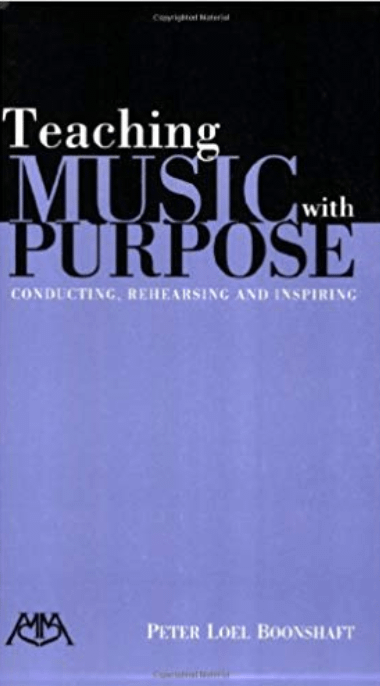 The next book I will share with you is Teaching Music with Purpose by Dr. Peter Boonshaft. Peter has written a trilogy of sorts: Teaching Music with Passion and Teaching Music with Promise are the first and third entries in the collection.
The next book I will share with you is Teaching Music with Purpose by Dr. Peter Boonshaft. Peter has written a trilogy of sorts: Teaching Music with Passion and Teaching Music with Promise are the first and third entries in the collection.
One thing you will notice immediately is the mind-boggling number of quotations in his books. These quotations are woven into the narrative quite skillfully.
If you are in the hunt for lots of inspirational quotes, you’ll find them in this book. As an admin note, I will present a number of quotes from the book and won’t bother with footnoting. Anything in italics is a direct quote from the book.
There are no answers here, no right or better way to do anything. What follows is simply food for thought….the right way isn’t always the opposite of the wrong way. Indeed, there’s lots of food for thought in the book. This reminded me of a conducting lesson I took with my long-time friend and mentor, Tony Maiello. He made it clear that there was no right or wrong way to conduct. Any technique that helped produce great music and was done for a purpose was “right.”
We can’t lose sight of the fact that our job is to see the greatness in each of our students; not just in their ability, but in them as people. We aren’t teaching skills or technique; we are teaching people! Not only that, we accept all students, not just the gifted ones.
If students are given a planned, prioritized procedure to achieve a goal, they can do it. Expectations alone are lofty ambitions, facilitated expectations are a staircase for success. This is the difference between true teaching and rote drills. We should set goals and then show the students how to achieve them.
I guess the bottom line is that we can never lose our desire to push our students further, but it must be managed so perspective is also never lost. Directing a professional group where the concert is the bottom line is quite different than being a music educator, no matter how successful or lauded your ensemble is. What if you put on a dazzling concert but it was done out of fear and intimidation or applied so much pressure that the students never really savored the music?
Every time you send a note home about a student’s progress, improvement or success you do far more than make someone’s day; you help make someone’s life. They may forget what you said, but I’m here to tell you, they will never forget how you made them feel. Wouldn’t it be great for a parent to hear from a teacher how appreciated their child is?
Air Drums. I won’t quote this chapter, but he has a brilliant solution for how to keep extra percussionists engaged in every piece of music. If students receive clear and meaningful communication from the conductor, they will be enticed and encouraged to watch for more. If the musicians aren’t watching, is it perhaps because they’ve decided there isn’t much to see?
A creative person is an explorer, artist, judge, and warrior. Our explorer is open to new ideas, wide-eyed and adventurous. The artist is creative and a bit crazy. The judge is critical and always the naysayer, while the warrior is persistent and determined to work toward any goal. Boonshaft describes how we can be more creative (there will be an upcoming book about that!) but we must keep these four traits in balance, so the creativity has purpose and utility.
We must possess the technique needed to accomplish our musical goals, but we can never lose sight of the fact that the purpose of technique is to serve art.
A Conductor’s Warm-up. A great chapter with advice on how to avoid injuries from conducting. I’ve had both rotator cuffs operated on and wish I had been doing these many years ago.
Independence of Hands. Dozens of sequential exercises to improve left-right hand independence. They start very easy and thankfully, don’t include conducting three in one hand and four in the other, which has always struck me as kind of useless.
Mindlessness negates concentration on tone quality, intonation, breathing, blend, balance, articulation or any of the other important concerns of a good warm-up session. Do you do the same warm-up routine every day? If the watershed moments of a student’s music education are limited to performances, they will be few and far between. If those moments occur in rehearsals, they will be many and often. Bring the intensity to rehearsals and the performances will take care of themselves.
Not Again – Better. Make sure you always tell them what you want done differently before launching into another “run through.”
No one is a failure who keeps trying. I’ve noticed that in our “testing era,” students seem to be terrified of being “wrong.” That may apply in math class, but not in music. We must encourage and destigmatize failure. If you are looking for a book that will remind you why you wanted to be a music educator and is also filled with lots of helpful knowledge, Teaching Music with Purpose is a great choice.
In the April 2020 Colonel’s Book Club, we’ll feature Peter Brown’s Make it Stick. In next month’s issue, we will discuss the power of our words. As always, feel free to contact me at ThomasPalmatier.com.








